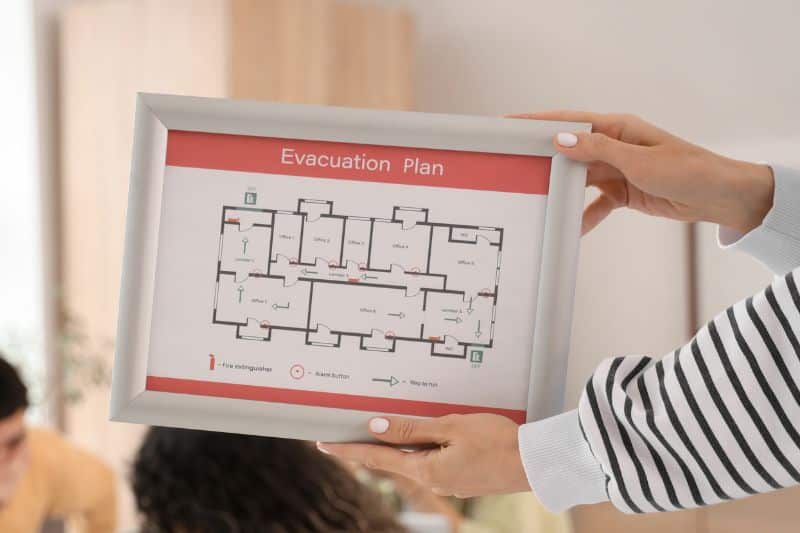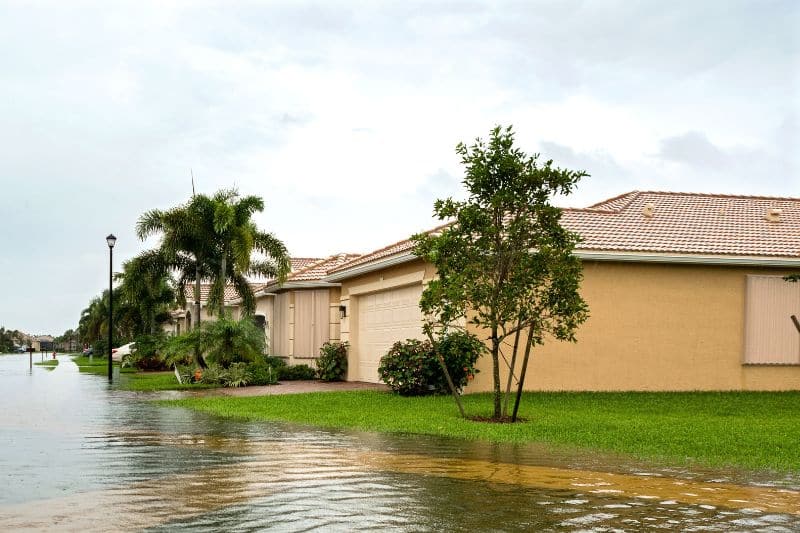Flooding is one of the most devastating natural disasters, and with climate change leading to more extreme weather events, its impact is becoming more widespread. Whether you live in a flood-prone area or just want to be prepared, taking steps to prevent and mitigate flood damage is essential. In this blog post, we’ll explore effective flood prevention and mitigation strategies to help protect your home and community from extreme weather.
Why It Matters?

Flooding can occur due to heavy rainfall, rapid snowmelt, hurricanes, storm surge, or even coastal storm surges. The increasing frequency of extreme weather events due to climate change has significantly contributed to the occurrence of flooding. The consequences of floods can be catastrophic: flooded or destroyed homes, displaced families, loss of life, and long-term economic hardship for affected others. In fact, the Federal Emergency Management Agency (FEMA) estimates that one inch of water can cause $25,000 in damage to a home.
Flood prevention mitigation involves steps you take to stop flooding before it happens, while flood mitigation focuses on minimizing the risk of flooding damage after it occurs. Both are crucial to your flood resilience and safeguarding your property, health, and financial future from flood waters. The good news is that many flood risks can be reduced with the right planning, preparation, and tools.
Key Flood Prevention & Mitigation Strategies

1. Understanding Your Flood Risk

The first step in flood prevention mitigation is understanding your risk level. To evaluate your current flood risk, you can use resources like Floodsmart.gov and FEMA’s Flood Insurance Rate Maps. These maps indicate the likelihood of flooding in your area, but keep in mind they may not fully reflect recent changes due to climate change. You can check if your home is in a very high flood risk area, flood zone by visiting FEMA’s website or using online tools from your local government. Once you know your risk, you can take more targeted actions to protect your property.
Effective floodplain management can also help in reducing flood risks by regulating land use in flood-prone areas.
2. Install Flood Barriers & Floodproofing Solutions

Flood barriers are one of the most effective ways to reduce the impact of flooding and prevent water from entering your home. Some options include:
- Flood gates or shields: These can be installed around doorways, windows, and other openings to stop water from flowing into the house.
- Temporary flood barriers: Easy to deploy before a storm, these barriers are designed to create a temporary but effective water barrier.
- Permanent floodproofing: In high-risk areas, you may want to consider permanent floodproofing measures, such as waterproof coatings, raised doors and windows, and installing sump pumps.
Understanding the implications of flood water on structural integrity is crucial. Implementing appropriate flood-proofing measures can protect homes, buildings, infrastructure and communities from potential inundation during heavy rains.
Floodproofing your home can also involve elevating the structure or critical components, like electrical systems, to a higher level to avoid water damage.
3. Landscaping and Grading

Proper landscaping and grading can help direct rainwater away from your home, reducing the chance of flooding. Here are some strategies to consider:
- Grade your yard: Ensure the ground slopes away from your foundation to prevent water from pooling around the house.
- Install French drains: These underground systems direct water away from vulnerable areas like basements and foundations.
- Use permeable pavement: Traditional concrete or asphalt surfaces can’t absorb rainwater, leading to runoff and possible flooding. Permeable materials like gravel or porous asphalt allow water to soak into the ground rather than flood your property.
Effective stormwater management practices can further enhance these landscaping strategies by using water retention, ensuring proper drainage and reducing runoff.
4. Install Sump Pumps and Backup Power

A sump pump is a crucial tool for preventing flooding in basements and crawl spaces. These devices pump out excess water that could otherwise accumulate and cause damage. Sump pumps are essential in preventing flood waters from accumulating in basements and crawl spaces. Here’s how you can enhance your flood prevention mitigation with sump pumps:
- Install a battery-powered backup: In case of power outages, a backup power system ensures your sump pump keeps running when you need it most.
- Regular maintenance: Make sure your sump pump is inspected and cleaned at least once a year to avoid blockages.
5. Flood-Resistant Building Materials

If you’re building a new home or renovating an existing property, consider using flood-resistant materials to your new construction to minimize water damage:
- Flood-resistant flooring: Materials like ceramic tile, stone, and certain types of vinyl are better at handling water than wood or carpet.
- Waterproof drywall and insulation: These materials can prevent mold and mildew growth if your home does experience flooding.
- Elevated foundations: Elevating your home above expected flood levels can prevent floodwaters from entering. In flood-prone areas, this is a standard practice for new constructions.
6. Maintain Gutters and Downspouts

Clogged gutters and downspouts are a common cause of basement flooding. When gutters are blocked by leaves, debris, or other obstructions, rainwater can overflow and seep into your basement or home’s foundation. To prevent this:
- Clean gutters regularly: At least twice a year, remove leaves and debris to ensure water flows freely.
- Install gutter guards: These devices help keep leaves and debris out of your gutters, reducing the frequency of cleaning.
- Extend downspouts: Direct rainwater at least 3-4 feet away from your foundation with properly installed downspout extensions.
7. Flood Insurance: Understanding Your Coverage

No matter how well you prepare, floods can still happen. It is crucial to consult an insurance agent to understand the logistics and costs associated home flooding and with protecting utilities and HVAC equipment from flood damage. That’s why flood insurance is a must for anyone living in a flood-prone area. FEMA’s National Flood Insurance Program (NFIP) offers coverage for homes and businesses. Even if you’re not in a high-risk flood zone, it’s worth considering, as flooding can affect any property. Be sure to check your policy for coverage details, as flood insurance policy typically does not cover things like basements or some types of damage.
8. Financial Protection: Safeguarding Your Assets
Financial protection is a crucial aspect of flood mitigation. Homeowners and businesses can take several steps to safeguard their assets from flood damage, ensuring they are better prepared for any flood event. Here are some measures to consider:
- Purchasing Flood Insurance: One of the most effective ways to protect your financial assets is by purchasing flood insurance. The National Flood Insurance Program (NFIP) offers policies to homeowners, renters, and businesses, providing coverage for flood damage that standard homeowners’ insurance does not. Even if you’re not in a high-risk flood zone, it’s worth considering, as flooding can affect any property.
- Creating a Flood Emergency Fund: Setting aside a portion of your budget for flood-related expenses can help you recover more quickly from a flood event. This fund can cover immediate costs such as temporary housing, food, and emergency repairs, reducing the financial strain during a flooding emergency.
- Documenting Your Assets: Keeping a detailed record of your assets, including photos and videos, can be invaluable in the aftermath of a flood. This documentation helps prove ownership and value, making the insurance claims process smoother and faster.
- Considering Flood-Resistant Materials: When building or renovating, using flood-resistant materials can significantly reduce the risk of flood damage. Materials like ceramic tile, stone, and waterproof drywall are better suited to withstand floodwaters, helping to protect your property and reduce repair costs.
By taking these proactive steps, you can better safeguard your financial assets and ensure a quicker recovery in the event of a flood.
8. Community-Level Flood Mitigation Efforts

Flood prevention mitigation isn’t just about individual buildings and homes—it’s also about the community. Local governments, residents and property owners can play a vital role in flood mitigation by:
Federal disaster assistance, provided as low-interest FEMA loans, is crucial for flood-related damages but is only available if the area is officially declared a natural disaster. This underscores the importance of obtaining flood insurance regardless of one’s flood zone classification.
- Building flood control infrastructure: This includes levees, dams, reservoirs, and flood walls to protect communities from rising waters.
- Improving stormwater drainage systems: Upgrading and maintaining storm drains can help prevent urban flooding during heavy rainfall.
- Community education: Local authorities can also help educate residents about flood risks and encourage better floodplain management practices.
9. Evacuation Plans & Emergency Preparedness

Sometimes, despite our best efforts, a flood may be unavoidable. Having a comprehensive evacuation plan is crucial to ensuring your family’s safety. Major flooding is a significant concern for many communities, making it essential for residents to be proactive in emergency planning. Key steps include:
- Know your evacuation routes: Identify the safest routes to higher ground and designated shelters.
- Create an emergency kit: Include essential items like food, water, medications, flashlights, and important documents.
- Stay informed: Use weather apps, NOAA radios, and emergency alerts to stay updated on flooding risks.
10. Effective Flood Management

Effective flood management is crucial to minimize the impact repair costs of flooding on communities. It involves a combination of strategies, including flood mitigation, preparedness, response, and recovery. By understanding the flood risk and taking proactive measures, communities can reduce the likelihood and severity of flood damage.
Flood mitigation efforts, such as building levees, dams, and floodwalls, can help control and redirect floodwaters. Preparedness involves educating the community about flood risks and ensuring that everyone knows what to do in the event of a flood. Response strategies include having emergency services ready to act quickly and efficiently during a flood event. Finally, recovery focuses on rebuilding and restoring the community after the floodwaters have receded.
By integrating these strategies, communities can create a robust flood management plan that not only addresses immediate threats from flood levels but also builds long-term flood resilience, against future flood events.
Reducing Flood Damage

Reducing flood damage requires a multi-faceted approach. One of the most effective ways to protect your property is by purchasing flood insurance. The National Flood Insurance Program (NFIP) provides flood insurance to homeowners, renters, and businesses in flood-prone areas. This insurance can help cover the cost of repairs and replacement of damaged property, offering a financial safety net in the aftermath of a flood.
In addition to purchasing flood insurance, communities can take proactive steps to mitigate flood risk. Implementing flood-control measures such as infrastructure such as levees, dams, and floodwalls can significantly reduce the impact of floodwaters. Adopting flood-resistant construction practices, such as elevating buildings in flood-prone areas, can also help minimize damage past floods.
Early warning systems play a critical role in reducing flood damage. By providing timely warnings of impending flood events, these first warning systems allow communities to evacuate people and secure property, thereby reducing the risk of injury and damage. Staying informed through weather apps, NOAA radios, and emergency alerts can make a significant difference in how well a community responds to a flooding emergency.
By combining these strategies, individuals and communities can better prepare for and respond to flood events, ultimately reducing the devastating impact of floodwaters.
Recovery and Restoration: Steps to Rebuild

Recovering from a flood can be a daunting task, but with a clear plan, you can rebuild and restore your property more effectively. Here are some essential steps to help you through the recovery process:
- Assessing the Damage: The first step is to take stock of the damage to your property. Prioritize repairs based on the severity of the damage and the safety of your home. Documenting the damage with photos and videos can also be helpful for insurance claims.
- Contacting Your Insurance Agent: Reach out to your insurance agent as soon as possible to report the damage and initiate the claims process. Provide them with all necessary documentation, including photos, videos, and a detailed list of damaged items. Your insurance agent can guide you through the next steps and help you understand your coverage.
- Cleaning and Disinfecting: Cleaning and disinfecting your property is crucial to prevent mold and mildew growth, which can cause long-term health issues and further damage. Use appropriate cleaning agents and protective gear to ensure a thorough and safe cleanup.
- Repairing and Rebuilding: Once the property is cleaned, you can begin making necessary repairs. Consider using flood-resistant materials for rebuilding to minimize future flood damage. Elevating electrical systems and other critical components can also help protect your home from future flood events.
- Seeking Professional Help: Depending on the extent of the damage, you may need to hire professionals to assist with the recovery and restoration process. Contractors, electricians, and mold remediation specialists can ensure that repairs are done correctly and safely.
By following these steps, you can effectively navigate flood waters and the recovery process and rebuild your property to be more resilient against future floods.
Final Thoughts

Flood prevention mitigation are not one-time tasks but ongoing efforts that require planning, investment, and vigilance. By understanding your flood risk, making strategic home improvements, and staying informed, you can significantly reduce the impact of flooding. Remember, the cost of taking preventive flood protection and flood resistance measures is far less than the cost of recovering from a flood. Whether you live in a high-risk flood zone or not, it’s always better to be safe than sorry. Prepare now, and you’ll have greater peace of mind when storm season arrives.

